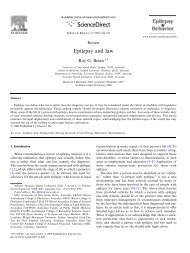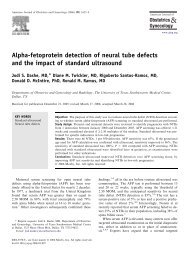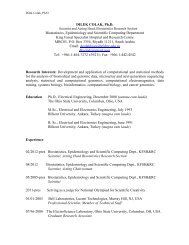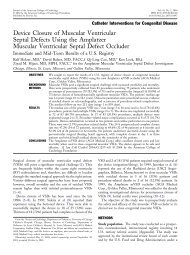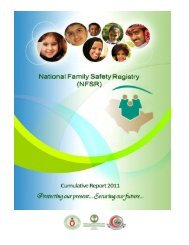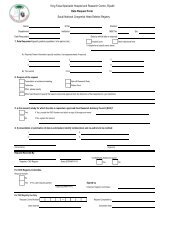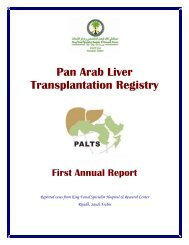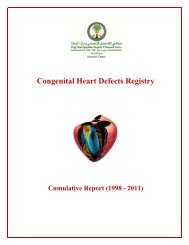Mortality from amyotrophic lateral sclerosis in ... - ResearchGate
Mortality from amyotrophic lateral sclerosis in ... - ResearchGate
Mortality from amyotrophic lateral sclerosis in ... - ResearchGate
Create successful ePaper yourself
Turn your PDF publications into a flip-book with our unique Google optimized e-Paper software.
Acta Neurol Scand 2001: 104: 232–235<br />
Pr<strong>in</strong>ted <strong>in</strong> UK. All rights reserved<br />
Copyright # Munksgaard 2001<br />
ACTA NEUROLOGICA<br />
SCANDINAVICA<br />
ISSN 0001-6314<br />
<strong>Mortality</strong> <strong>from</strong> <strong>amyotrophic</strong> <strong>lateral</strong> <strong>sclerosis</strong><br />
<strong>in</strong> F<strong>in</strong>land, 1986–1995<br />
Maasilta P, Jokela<strong>in</strong>en M, Löytönen M, Sabel CE, Gatrell AC.<br />
<strong>Mortality</strong> <strong>from</strong> <strong>amyotrophic</strong> <strong>lateral</strong> <strong>sclerosis</strong> <strong>in</strong> F<strong>in</strong>land, 1986–1995.<br />
Acta Neurol Scand 2001: 104: 232–235. # Munksgaard 2001.<br />
Objective – To study the possible changes, between 1986 and 1995, <strong>in</strong><br />
the mortality due to <strong>amyotrophic</strong> <strong>lateral</strong> <strong>sclerosis</strong> (ALS) among<br />
F<strong>in</strong>nish patients. Materials and methods – A total of 1000 deaths <strong>from</strong><br />
ALS were extracted <strong>from</strong> the F<strong>in</strong>nish Death Certificate Register for<br />
the study years. General population data were obta<strong>in</strong>ed <strong>from</strong> the<br />
Statistical Yearbooks of F<strong>in</strong>land. Results – From a death rate of 1.54/<br />
100,000 <strong>in</strong> 1986 an <strong>in</strong>crease to 2.27/100,000 <strong>in</strong> 1995 was observed.<br />
S<strong>in</strong>ce 1963 the number of ALS deaths has tripled. The documented<br />
<strong>in</strong>creased life-expectancy <strong>in</strong> F<strong>in</strong>land correlates with the ALS death<br />
rate, at least partly expla<strong>in</strong><strong>in</strong>g the <strong>in</strong>crease. Contrary to other<br />
countries, on the whole equal numbers of men and women died of<br />
ALS. Women tended to be older than men when they died of ALS.<br />
Conclusion – In accordance with other countries ALS mortality <strong>in</strong><br />
F<strong>in</strong>land is steadily <strong>in</strong>creas<strong>in</strong>g.<br />
P. Maasilta 1 , M. Jokela<strong>in</strong>en 2 ,<br />
M. Löytönen 3 , C. E. Sabel 4 ,<br />
A. C. Gatrell 5<br />
1 Department of Pulmonary Medic<strong>in</strong>e, Hels<strong>in</strong>ki<br />
University Central Hospital, Hels<strong>in</strong>ki, F<strong>in</strong>land;<br />
2 Harjukatu 40 C 3, Lahti, F<strong>in</strong>land; 3 Department of<br />
Geography, University of Hels<strong>in</strong>ki, Hels<strong>in</strong>ki, F<strong>in</strong>land;<br />
4 School of Geography & Geosciences, University of St<br />
Andrews, St Andrews, United K<strong>in</strong>gdom; 5 Institute for<br />
Health Research, Lancaster University, Lancaster,<br />
United K<strong>in</strong>gdom<br />
Key words: <strong>amyotrophic</strong> <strong>lateral</strong> <strong>sclerosis</strong>; mortality;<br />
F<strong>in</strong>land<br />
P. Maasilta, Department of Pulmonary Medic<strong>in</strong>e,<br />
Hels<strong>in</strong>ki University Central Hospital, P.O. Box 340,<br />
FIN-00029 HUS, F<strong>in</strong>land<br />
Tel.: +358 9 471 60083<br />
Fax: +358 9 471 74020<br />
e-mail: paula.maasilta@hels<strong>in</strong>ki.fi<br />
Accepted for publication April 17, 2001<br />
The occurrence of <strong>amyotrophic</strong> <strong>lateral</strong> <strong>sclerosis</strong><br />
(ALS), the ma<strong>in</strong> variant of motor neurone disease<br />
(MND), has for years been followed <strong>in</strong> many<br />
countries (1, 2). ALS patient data have been<br />
collected <strong>from</strong> records kept by primary care<br />
physicians, neurologists and hospital discharge<br />
registers. Health <strong>in</strong>surance records and mortality<br />
statistics have also been utilized.<br />
Descriptive epidemiological studies have<br />
revealed the magnitude of the burden which this<br />
disease constitutes to both health care and human<br />
resources. Analytic epidemiological studies (3, 4)<br />
have shed some light upon the possible aetiological<br />
risk factors. Despite extensive research on<br />
the subject, the aetiology and pathogenesis of this<br />
devastat<strong>in</strong>g disease are still unclear, pos<strong>in</strong>g a<br />
challenge to the research community (5).<br />
The epidemiology of ALS <strong>in</strong> F<strong>in</strong>land has been<br />
studied s<strong>in</strong>ce 1975 (6) by utiliz<strong>in</strong>g various data<br />
sources <strong>in</strong>clud<strong>in</strong>g the Death Certificate Register.<br />
The latest mortality study cover<strong>in</strong>g the years<br />
1963–1982 was published <strong>in</strong> 1987 (7). ALS<br />
mortality <strong>in</strong> F<strong>in</strong>land has been constantly <strong>in</strong>creas<strong>in</strong>g,<br />
mirror<strong>in</strong>g the situation <strong>in</strong> several other<br />
European countries such as Sweden (8, 9),<br />
Norway (10), England (4), and Italy (11).<br />
<strong>Mortality</strong> statistics <strong>in</strong> MND may be sufficient<br />
for study<strong>in</strong>g trends with time (3), and possibly<br />
variation <strong>in</strong> place, but are likely to underestimate<br />
rates <strong>in</strong> the elderly, particularly <strong>in</strong> medically<br />
deprived areas, where age-specific rates may be<br />
higher than reported.<br />
In 2000, a novel approach to the epidemiology<br />
of ALS was <strong>in</strong>troduced by a British–F<strong>in</strong>nish<br />
research team by us<strong>in</strong>g time geography as the<br />
conceptual framework. Utiliz<strong>in</strong>g data <strong>from</strong> the<br />
F<strong>in</strong>nish Death Certificates Registry this team<br />
adapted a geographical <strong>in</strong>formation system<br />
(GIS)-based approach where spatial and temporal<br />
patterns were revealed us<strong>in</strong>g a spatial estimation<br />
technique known as kernel estimation (12). The<br />
present study was designed to exam<strong>in</strong>e the<br />
232
ALS mortality <strong>in</strong> F<strong>in</strong>land 1986–1995<br />
possible changes <strong>in</strong> the mortality of F<strong>in</strong>nish ALS<br />
patients by analys<strong>in</strong>g the mortality trend <strong>from</strong><br />
1986–1995.<br />
Material and methods<br />
A total of 1000 deaths <strong>from</strong> ALS were recovered<br />
<strong>from</strong> the digitally recorded F<strong>in</strong>nish Death<br />
Certificate Register cover<strong>in</strong>g years 1986–1995.<br />
All data were obta<strong>in</strong>ed <strong>from</strong> <strong>in</strong>dividual-level<br />
register-based computerized databases. The<br />
yearly data comprised sex, date and place of<br />
birth, and date of death (12). All ALS patients<br />
<strong>in</strong>cluded <strong>in</strong> this study were born <strong>in</strong> F<strong>in</strong>land. S<strong>in</strong>ce<br />
1976 all hospital districts <strong>in</strong> F<strong>in</strong>land have had a<br />
Neurology department run by specialists, who<br />
make all ALS diagnoses.<br />
The ALS mortality data <strong>from</strong> 1963 to 1982 was<br />
obta<strong>in</strong>ed <strong>from</strong> one of the authors (M.J.).<br />
Data on the general population were obta<strong>in</strong>ed<br />
<strong>from</strong> the Statistical Yearbook of F<strong>in</strong>land (13).<br />
Spearman’s correlation was used for correlation<br />
analysis. All computations were performed us<strong>in</strong>g<br />
a commercial statistical package (Statistica 2 v. 5,<br />
StatSoft Inc., Tulsa, OK, USA).<br />
Results<br />
The population of F<strong>in</strong>land was 4,539,500 <strong>in</strong> 1963,<br />
4,910,664 <strong>in</strong> 1986, and by 1995 had <strong>in</strong>creased to<br />
5,116,826. The number of ALS deaths <strong>in</strong>creased<br />
steadily dur<strong>in</strong>g the period <strong>from</strong> 1963 to 1995. In<br />
1963 40 people died of ALS and <strong>in</strong> 1995 116<br />
people. Also the ALS death rate/100,000 has<br />
steadily <strong>in</strong>creased <strong>from</strong> 0.85 <strong>in</strong> 1963 and 1.54 <strong>in</strong><br />
1986 to 2.27 <strong>in</strong> 1995 (r=0.912, P
Maasilta et al.<br />
Fig. 4. The mean age and standard deviation at death <strong>from</strong><br />
<strong>amyotrophic</strong> <strong>lateral</strong> <strong>sclerosis</strong> <strong>in</strong> men and women <strong>in</strong> F<strong>in</strong>land<br />
<strong>from</strong> 1986 to 1995.<br />
Discussion<br />
In accordance with data <strong>from</strong> other countries (4,<br />
8–11) and previous data <strong>from</strong> F<strong>in</strong>land (7) this<br />
study shows a substantial <strong>in</strong>crease <strong>in</strong> ALS<br />
mortality. Also the annual death rate is on the<br />
<strong>in</strong>crease without any cyclic or other variation. In<br />
less than 25 years s<strong>in</strong>ce 1963 the number of ALS<br />
deaths has tripled, while the population has<br />
<strong>in</strong>creased only by 11.3%.<br />
Most of the ALS deaths occurred <strong>in</strong> the over-55<br />
population. Previously <strong>in</strong> F<strong>in</strong>land the mean age at<br />
death <strong>from</strong> ALS had <strong>in</strong>creased <strong>from</strong> 62 <strong>in</strong> 1963 to<br />
66 <strong>in</strong> 1982 with no change <strong>in</strong> the mean duration<br />
of disease (7). We found the mean age at death to<br />
be 66.5 <strong>in</strong> 1995. There has been no major change<br />
<strong>in</strong> the treatment of this disease <strong>in</strong> F<strong>in</strong>land dur<strong>in</strong>g<br />
the study years, but the life-expectancy of the<br />
population <strong>in</strong> general has <strong>in</strong>creased throughout<br />
the years. Similar to our f<strong>in</strong>d<strong>in</strong>gs a maximal<br />
<strong>in</strong>cidence rate of between 61 and 65 years, with a<br />
median survival of 28 months has been reported<br />
<strong>from</strong> Norway dur<strong>in</strong>g the time-period <strong>from</strong> 1978 to<br />
1988 (10).<br />
Most studies report a higher <strong>in</strong>cidence of ALS<br />
<strong>in</strong> men compared to women of 1:1.5 to 2:1 (10,<br />
15). Although the forms of ALS have been<br />
reported to vary <strong>in</strong> men and women (15) there<br />
are no data <strong>in</strong>dicat<strong>in</strong>g a gender difference <strong>in</strong><br />
survival. In an earlier study <strong>from</strong> F<strong>in</strong>land the<br />
mortality men:women ratio was 0.94 to 1 (14).<br />
Our f<strong>in</strong>d<strong>in</strong>g is similar to that. With a large yearly<br />
fluctuation roughly the same number of men and<br />
women died of ALS. Aga<strong>in</strong> no cyclic or other<br />
pattern was seen. In general women live noticeably<br />
longer than men <strong>in</strong> F<strong>in</strong>land (13). The shorter<br />
life-expectancy of men could be one of the factors<br />
expla<strong>in</strong><strong>in</strong>g the equal gender ratio <strong>in</strong> the ALS<br />
death rate <strong>in</strong> F<strong>in</strong>land. We also analysed the<br />
potential effect of the second world war as<br />
regards the gender ratio. No identifiable effect<br />
Fig. 5. Scatter plot show<strong>in</strong>g the annual deathrate <strong>from</strong> <strong>amyotrophic</strong><br />
<strong>lateral</strong> <strong>sclerosis</strong> versus the life-expectancy <strong>in</strong> F<strong>in</strong>land<br />
<strong>from</strong> 1963 to 1995.<br />
could be found; the annual rate of the ALS cases<br />
is so small that it accommodates for the slightly<br />
higher overall mortality of men caused by the<br />
war.<br />
We showed that the <strong>in</strong>creas<strong>in</strong>g life-expectancy<br />
of the population <strong>in</strong> F<strong>in</strong>land correlates with the<br />
ALS death rate. Thus the <strong>in</strong>creased age of the<br />
population at least partly expla<strong>in</strong>s the <strong>in</strong>creased<br />
death rate of ALS. A study <strong>from</strong> Sweden with a<br />
similar health care system and comparable<br />
homogenous population characteristics to<br />
F<strong>in</strong>land showed that a subpopulation susceptible<br />
to MND exists there (9). The <strong>in</strong>creased life<br />
expectancy of the population <strong>in</strong> Sweden has<br />
resulted <strong>in</strong> more people liv<strong>in</strong>g to the ages, when<br />
MND is expressed (9). Although our study was<br />
not designed to look at the roles of <strong>in</strong>creased<br />
population life expectancy and environmental<br />
factors respectively, it is likely that the situation<br />
<strong>in</strong> F<strong>in</strong>land would be identical to that <strong>in</strong> Sweden.<br />
We undertook a retrospective study based on<br />
death certificates. However, the possible sources<br />
of errors <strong>in</strong> our study are <strong>in</strong>significant. The<br />
sample comprises all ALS deaths <strong>from</strong> 10 years<br />
and is large enough to control for random<br />
fluctuation. Also, all ALS diagnoses are made<br />
by neurologists <strong>in</strong> F<strong>in</strong>land, which makes diagnostic<br />
errors unlikely.<br />
Acknowledgements<br />
The study has been funded by the Hels<strong>in</strong>ki University Central<br />
Hospital Special Funds.<br />
References<br />
1. CHANCELLOR AM, WARLOW CP. Adult onset motor neurone<br />
disease: worldwide mortality, <strong>in</strong>cidence and distribution<br />
s<strong>in</strong>ce 1950. J Neurol Neurosurg Psychiatry 1992;55:1106–15.<br />
2. ROMAN G. Neuroepidemiology of <strong>amyotrophic</strong> <strong>lateral</strong><br />
<strong>sclerosis</strong>: clues to aetiology and pathogenesis. J Neurol<br />
Neurosurg Psychiatry 1996;59:131–7.<br />
234
ALS mortality <strong>in</strong> F<strong>in</strong>land 1986–1995<br />
3. NEILSON S, ROBINSON I, CLIFFORD RF, HUNTER M. Ris<strong>in</strong>g<br />
mortality <strong>from</strong> motor neurone disease: an explanation. Acta<br />
Neurol Scand 1993;87:184–91.<br />
4. SABEL CE, GATRELL AC. Exploratory spatial data analysis of<br />
motor neurone disease <strong>in</strong> North West England: beyond the<br />
address at diagnosis. In: GIERL L, et al., eds. GEOMED ’97:<br />
Proceed<strong>in</strong>gs of the International Workshop on Geomedical<br />
Systems. Stuttgart: Teubner-Verlag, 1998.<br />
5. EISENA. Amyotrophic <strong>lateral</strong> <strong>sclerosis</strong>: a synthesis of research<br />
and cl<strong>in</strong>ical practice. Cambridge: Cambridge University<br />
Press, 1998.<br />
6. JOKELAINEN M, PALO J, WIKSTRÖM J. The distribution of <strong>amyotrophic</strong><br />
<strong>lateral</strong> <strong>sclerosis</strong> <strong>in</strong> F<strong>in</strong>land. J Neurol Sci 1975:473–9.<br />
7. JOKELAINEN M. Amyotrophic <strong>lateral</strong> <strong>sclerosis</strong> <strong>in</strong> F<strong>in</strong>land. In:<br />
COSI V, et al., eds. Amyotrophic Lateral Sclerosis. Therapeutic,<br />
Psychological and Research Aspects. New York;<br />
Plenium Press, 1987.<br />
8. GUNNARSSON L-G, LINDBERG G, SÖDERFELT B, AXELSON O.<br />
<strong>Mortality</strong> of motor neurone disease <strong>in</strong> Sweden. Arch Neurol<br />
1990;47:42–7.<br />
9. NEILSON S, GUNNARSSON L-G, ROBINSON I. Ris<strong>in</strong>g mortality<br />
<strong>from</strong> motor neurone disease <strong>in</strong> Sweden 1961–1990; the relative<br />
role of <strong>in</strong>creased population life expectancy and environmental<br />
factors. Acta Neurol Scand 1994;90:150–9.<br />
10. TYSNES O-B, VOLLSET SE, AARLI JA. Epidemiology of <strong>amyotrophic</strong><br />
<strong>lateral</strong> <strong>sclerosis</strong> <strong>in</strong> Hordaland county, western<br />
Norway. Acta Neurol Scand 1991;83:280–5.<br />
11. CHI A, MAGNANI C, SCHIFFER D. Amyotrophic <strong>lateral</strong> <strong>sclerosis</strong><br />
mortality <strong>in</strong> Italy, 1958 to 1987: a cross sectional and cohort<br />
study. Neurology 1993;43:927–30.<br />
12. SABEL CE, GATRELL AC, LÖYTÖNEN M, MAASILTA P,<br />
JOKELAINEN M. Model<strong>in</strong>g exposure opportunities: estimat<strong>in</strong>g<br />
relative risk for motor neurone disease <strong>in</strong> F<strong>in</strong>land. Soc Sci &<br />
Med 2000;50:1121–37.<br />
13. Statistical Yearbook of F<strong>in</strong>land 1998. Statistics F<strong>in</strong>land,<br />
Hels<strong>in</strong>ki 1998.<br />
14. JOKELAINENM. Amyotrophic <strong>lateral</strong> <strong>sclerosis</strong> <strong>in</strong> F<strong>in</strong>land. Acta<br />
Neurol Scand 1977;56:185–93.<br />
15. TRYNOR BJ, CODD MB, CORR B, FORDE C, FROST E,<br />
HARDIMAN O. Incidence and prevalence of ALS <strong>in</strong> Ireland,<br />
1995–1997; A population-based study. Neurology 1999;<br />
52:504–9.<br />
235




